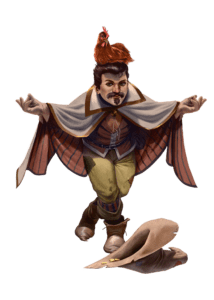
Roleplaying in a game is one of the most effective ways a player can interface with their character and immerse themselves into the world of the game. A common concern among newer players however, is that they don’t believe they can think on their feet, so they can’t roleplay in what they believe is a meaningful way.
Luckily, it’s easy to cultivate improvisation skills! The dirty secret of improv is that you can practice it. You’re at the table anyway, so try these games and tools to improve your skills.
What is Improv?
Improv (Improvised) comedy is a performing art in which the performers work together to develop scenes with little or no preparation. In short, improv is the ability to think on your feet in a meaningful, not random, way.
Roleplaying in a tabletop RPG follows the same format as performing in an improv show. So players and GMs alike can benefit from implementing improv strategies that performers practice to improve the quality of their game. Let’s start with LARCH.
What is LARCH?
LARCH stands for Location, Action, Relationship, Character, and History. These 5 aspects are the core building blocks to any good scene. (“Scene” here means any moment of a game when roleplaying is in the forefront.)
At the table, when it’s time to talk, keep these five aspects in mind. A scene that incorporates all of them successfully will feel full and create a welcoming space for roleplay. As both a player and a GM, do your best to introduce any of these aspects that seem to be missing.
Location: Where Are We?
The other elements of LARCH tend to rely heavily on the location that a scene takes place in, since it’s easier to insert actions and characters into an agreed-upon area than the other way around.
Your GM typically establishes the important details of where your character is and what they are surrounded by. Let the location of a scene inspire how your character might behave in that location.
- Are you trudging through a humid swamp? Try talking slightly out of breath or winded.
- Do you find yourself in a crowded square? Raise your voice a little bit to talk over the people.
- Are you in a formal dinner? Occasionally interrupt your speech by acknowledging a server.
Roleplaying doesn’t need to be a major undertaking, like a full character voice. Minor changes to the way you speak or sit can do wonders to immerse yourself and your fellow players into the location of the game and get you more comfortable in taking larger risks.
Action: What Are We Doing?
The second major grounding force in a scene is physically doing something rather than just talking about doing something. Back in the swamp, many insects bite at you as you traverse it. How could you communicate to the other players “Wow, these bugs sure are annoying, aren’t they?” without just saying that? You can swat your arm every now and then or wave your hand in front of you to ward off a cloud of insects.
GMs can incorporate action into their descriptions as well. As you set the scene for this gigantic swamp, react physically to the insects and heat you describe. This gives players a richer image in their heads to imagine.
Relationship: How Do We Know Each Other?
Rarely does a performer act all alone in a scene. And in a roleplaying game, it’s practically impossible, since a player always has the other players and GM to bounce off of. Identifying the relationship between two characters (NPC or otherwise) can help to inform your choices in how you interact with that other character.
In a scene is between two players, determining the relationship is easy. It naturally develops over the course of several game sessions. However, in a game that you only play once or when you interact with a brand new NPC, you don’t have the luxury of waiting for a relationship to develop. You need to find one and play with it quickly!
To pull this off, decide your character’s first impression of another character. Are they annoying, charming, trustworthy, or anything in between? Just pick one. Then talk to that character as if that piece of information is the only thing you need to know about them. Each time you encounter them in the future, pick a new impression based on the first one, and continue to develop it from there.
Character: Who Are We?
In a typical improv show, performers don’t know anything about the characters they will perform. They develop them with their scene partner. A roleplaying game gives you one up on them—you already know exactly who your character is and what they believe.
During character creation, many games give players the ability to determine personality traits, flaws, and ideals. As a GM, encourage your players to think about these aspects of their characters and lean into them. As a player, keep an eye out for opportunities to call upon your character traits for inspiration during a scene. These can help you establish the other elements of LARCH and how your character feels about each one.
History: What Have We Done Before This Moment?
History refers to any event that happened before the current scene. By coloring a scene with some sort of history, it creates an undertone to every word said and action taken, giving it depth.
History can naturally develop over time, or you can declare one in the moment. Perhaps a PC is interacting with a shopkeeper from their hometown. Did they steal from the shop in their youth? Did the shopkeeper rip them off in the past? History directly feeds into Relationship, which then helps to establish the other elements of LARCH.
